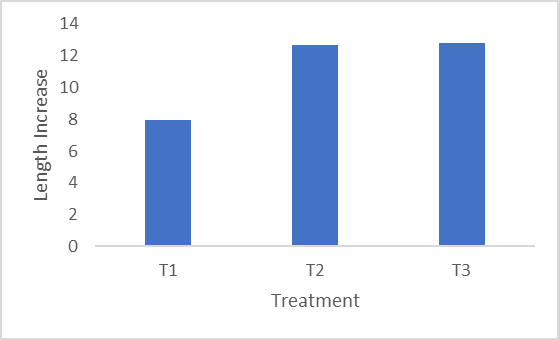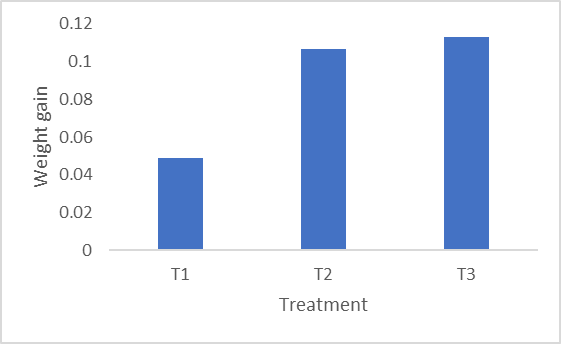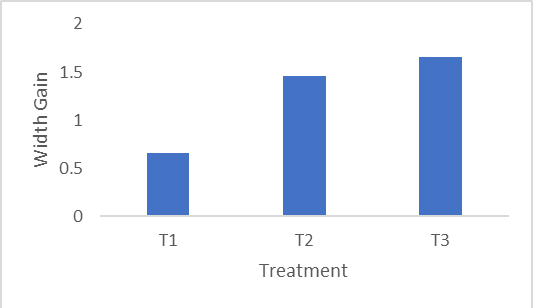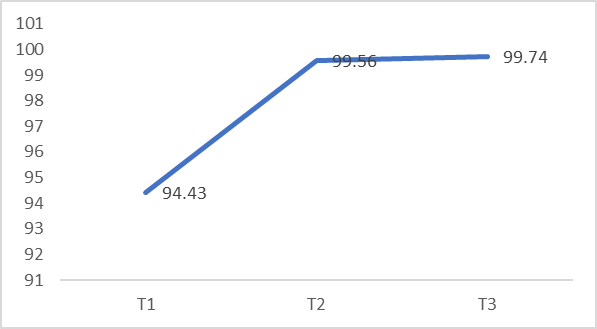Effect of Substrate Moisture on the Growth Performance and Survivability of the Black Soldier Fly (Hermetia illucens L.) Larva
- O. Okpoko
- C. I. Ebenebe
- J. J. Okeke
- M. I. Amobi
- A. C. Umeaniebue
- 1-8
- May 27, 2024
- Microbiology
Effect of Substrate Moisture on the Growth Performance and Survivability of the Black Soldier Fly (Hermetia illucens L.) Larva
O. Okpoko1*, C. I. Ebenebe2, J. J. Okeke3, M. I. Amobi4, A. C. Umeaniebue3
1Department of Biology and Forensic Science, Admiralty University of Nigeria, Ibusa/Ogwashi-uku Express Way, Delta State, Nigeria.
2Department of Animal Science, Nnamdi Azikiwe University, Awka, Anambra State, Nigeria.
3Department of Zoology, Nnamdi Azikiwe University, Awka, Anambra State, Nigeria
4Department of Biological Sciences, Federal University of Kashere, Gombe State, Nigeria
*Corresponding Author
DOI: https://doi.org/10.51584/IJRIAS.2024.905001
Received: 03 April 2024; Accepted: 23 April 2024; Published: 27 May 2024
ABSTRACT
The production and supply of animal protein are dropping with the increasing world population, especially in developing countries like Nigeria. Some alternatives such as several edible insects are challenged by people’s unwillingness to engage in entomophagy. Therefore, the need to improve animal protein production and supply has necessitated measures that can curb the major issue in this sector, which is the high feed cost occasioned by the scarce and expensive fishmeal used as the animal protein source in feeds. Black soldier fly which feeds on low-cost organic wastes can bridge the gap between entomophagy and animal protein supply as an indirect source of animal protein by substituting the expensive fishmeal in animal feed. However, though the larva of the black soldier flies can thrive in almost all organic substrates, it has its moisture requirement for survival, growth and development. In this research poultry droppings were used at three different moisture levels of 30%, 50% and 70% to rear the larva. The larvae reared at 70% moisture level had the best growth performance in terms of length, weight and width gain, although the length increase did not vary significantly between the larvae reared at 50% moisture and those reared at 70% moisture level. The lowest performance for all growth parameters examined was observed from larvae reared at 30% moisture level. The survival rate for larvae reared at 50% and 70% moisture levels did not vary significantly but were both significantly higher than that of those reared at 30% moisture level. The results showed that the larvae black soldier flies thrive better at substrate moisture levels above 50%.
Keywords- animal protein, black soldier fly larva, fishmeal, substrate moisture, growth, survivability.
INTRODUCTION
The geometric increase in the world’s population which has outmatched the supply of animal protein is worrisome [1]. The conventional animal protein supply sources have failed to meet the current rising demand for animal protein in Nigeria exacerbated by the ever-increasing cost of animal feed. For this reason, protein-energy malnutrition is still common in Nigeria as a result of low protein intake due to scarce and expensive animal protein sources [2]. Insect proteins could be a solution to the nation’s animal protein shortage because they provide cheap, high amino-acid protein with little or no impact on the environment [3]. To augment animal protein supply, farmers have been urged to adopt mini-livestock farming, such as insect farming [4]. However, the acceptance of entomophagy still stands in the way, as many people still perceive insect consumption as disgusting. To this effect, the use of larva of Black Soldier Fly (BSF) as a protein source in animal feed seems to be a good choice as an indirect alternative to direct entomophagy while reducing the cost of animal feed by replacing the high-cost fishmeal conventionally used in animal feed formulation. There is therefore need to intensify research into mass-producing the BSF larva for sustainable use as fishmeal alternative in animal feeds. Since BSF larvae are photophobic [5], they are usually found underneath the substrates (organic materials), away from bright light.
Several reports have been published on the production of BSF using different organic wastes as substrates [6], [7], [8]. Such organic wastes include poultry droppings, pig manure, brewers waste and kitchen waste.
However, moisture content in the rearing substrate is an important variable in the BSF larvae production [9]. BSF larvae have been shown to grow and develop into pupae at substrate moisture contents of 30–70% (based on weight) [10]. Other studies suggest that substrate moisture contents in the range of 50–80% are optimal for larval development, final weight, feed conversion efficiency, and yield [11], [12], [13], [14], [15]. However, BSF larvae have even been grown at substrate moisture contents of 90–97.5%, but with lower survival rates and reduced body weights than at 75–88% substrate moisture [16]. The substrate moisture content influences substrate texture and affects larval movement, feed consumption, growth and survival [17], [18], [13]. In this research, different moisture rates were applied to the rearing medium (poultry droppings) to access the growth performance of the larva in each treatment.
The present study therefore presents the effect of the black soldier fly larva meal diet on the carcass quality of Clarias gariepinus.
MATERIALS AND METHOD
- Processing of Rearing Substrate
The substrate, Poultry Droppings (PD,) was wet at the point of collection and was therefore spread out to air-dry under a shade. The dried substrate was ground to fine particles of 2-5mm size using a Silver Crest electric blender (Model: 2030D). The grinding of the substrate to smaller particle size was to enhance the waste processing since the BSF larvae do not have appropriate mouthparts to break apart large chunks of waste [19]. The different dried substrates were thereafter packaged and stored in dry bags at room temperature. Before the commencement of the experiment, the substrate for each treatment was weighed and the required volume of water for the different moisture ratios was added. The moisture: substrate ratios used in the experiment were 30% moisture: 70% substrate (30:70), 50% moisture: 50% substrate (50:50) and 70% moisture: 30% substrate (70:30).
A. Management of BSF Larvae
Two thousand (2000) five-days old (5-DOL) larvae were transferred into each replicate container of the various rearing containers (30 x 15 x 10cm) containing 3kg (wet-weight) each of the substrate at different moisture ratios. About eighteen thousand (18,000) 5-DOL larvae with an average weight of 0.03g were used for the growth experiment. The number of 5-DOL larvae was estimated by counting the number of larvae in a small sample (approximately 2g), which then was extrapolated based on the total weight of all 5-DOL required per treatment [19]. The rearing containers (larveros) used were white transparent containers measuring 40 x 20 x 15cm. These containers were used because of their availability and affordability in the market. The rearing containers were kept in the dark cage for the 12 days rearing duration, since BSF larvae are photophobic [5].
B. Harvesting of BSF Larvae
BSF larvae were harvested after twelve (12) days when data collection was ended at the observation of the first prepupae. Boiled water was poured into rearing containers to kill the larvae and to also clean and purge them of their gut contents [19]. The dead larvae floated on the water while the substrates settled below. The dead larvae were scooped with a plastic sieve of mesh size 3mm.
C. Data Collection
20 larvae were sampled from each replicate and weighed with an electronic scale (Ming Heng Digital Scale-777) once every three (3) days to get the mean weight per larva. At day 12 of the experiment, the final mean weight per larva was used to divide the total weight of larvae per treatment to get the number of larvae surviving per treatment at the end of the experiment. Body length was measured by placing the ends of a pair of compasses one at the tip of the head and the other at the rear end of the body of the larva and then tracing out the measurement value on a centimeter measurement ruler. The same method was used to measure body width increase after placing the pair of compasses each on the two ends of the body girth. Larval growth was followed till the first prepupae emerged from the substrate.
D. Survivability
As was done at the beginning of the experiment, the number of larvae surviving at the end of the experiment was obtained and recorded. This was done by first weighing a sample size of 20 larvae per replicate. The weight was then divided by the number of larvae (20) to get the average weight of a larva. The weight of the entire larvae per replicate was taken and then divided by the average weight of a larva to get the total number of larvae per replicate. Survivability was calculated by dividing the initial number of larvae by the final number of larvae and multiplying by hundred (100).
E. Statistical Analysis
Analysis of variance (ANOVA) was used to analyse the data generated and differences in means separated using Duncan Multiple Range Test. The statistical analysis was carried out with IBM SPSS version 23.
RESULTS
A. Length Increase (mm) of Black Soldier Fly Larvae Reared at Different Moisture: Substrate Ratios
The results of length gain as shown in Figure 1 revealed that there was a statistically significant difference between the effects of the different moisture levels on the length gain of BSF larvae, P = 0.000. The length increases varied across the moisture: substrate ratios. Larvae reared on 70:30 moisture: substrate ratio (T3) recorded the highest statistically significant mean length gain (12.7733 ± 0.0819), whereas larvae reared on 30:70 moisture ratio (T1) had the lowest statistically significant mean value (7.9800 ± 0.01732). However, the length increase obtained for larvae reared on moisture: substrate ratios of 70:30 (T2) was not statistically different from that of larvae reared on moisture: substrate ratio of 50:50 (12.6833 ± 0.0273).
Figure 1: Length Increase (mm) of Black Soldier Fly Larvae Reared at Different Moisture: Substrate Ratios
B. Weight Gain (g) of Black Soldier Fly Larvae Reared at Different Moisture: Substrate Ratios
The result of the mean weight gain of larva reared at the different moisture: substrates ratios (Figures 2) showed that there was a statistically significant effect of the moisture levels on the weight gain of larva (P<0.05). The larvae reared on a moisture: substrate ratio of 70:30 (T3) performed best among the moisture: substrates ratios (0.1133 ± 0.0009), followed by those of treatment T2, (0.1067 ± 0.0015) which had 50:50 moisture: substrate ratio. The least weight gain (0.0487 ± 0.0018) was observed for larvae reared on a 30:70 moisture substrate ratio (T1).
Figure 2: Weight Gain (g) of Black Soldier Fly Larvae Reared at Different Moisture: Substrate Ratios
C. Width Gain (mm) of Black Soldier Fly Larvae Reared at Different Moisture: Substrate Ratios
The result of the width gain of the BSF reared at the different moisture: substrate ratios is shown in Figure 3. The result showed that the different moisture levels (P = 0.000) had a significant effect on the width gain of BSFL. The larvae reared in moisture: substrate ratio of 70:30 (T3) gained the highest statistically significant mean width value (0.1133 ± 0.0009), and the lowest value was recorded for larvae reared on T1 (0.6533 ± 0.1102) which had moisture: substrate ratio of 30:70.
Figure 3: Width Gain (mm) of Black Soldier Fly Larvae Reared at Different Moisture: Substrate Ratios
D. Survivability of Black Soldier Fly Larvae Reared at Different Moisture: Substrate Ratios
The result of statistical analysis showed that the survivability of BSFL varied significantly at the different moisture: substrate ratios (P = 0.000). Survivability of larva across the three moisture: substrates ratios was high. However, the separation of means using the Duncan Multiple Range Test showed that the larvae reared at 30:70 moisture: substrate ratio had significantly lowest value (94.43 ± 0.8622), whereas the survivability for larvae reared at 50:50 and 70:30 moisture: substrate ratios did not vary significantly.
Figure 4: Survivability of Black Soldier Fly Larvae Reared at Different Moisture: Substrate Ratios
DISCUSSION
A. Length Increase
Literature is scarce on the use of length as a measurement parameter for larval growth. However, the study on length increase of the larvae at the different moisture rates revealed that the moisture level of rearing substrate had significant effect on the length increase of larvae. BSF larvae in T3 (70% moisture:30%nsubstrate) recorded the highest value of length increase, which was found not to be significantly different from that of larvae reared at 50% mpositure:50% substrate (T2). On the other hand, BSF larvae reared at 30% moisture:70% substrate (T1) recorded 7.9800 ± 0.01732 length increase, which was statistically found to be significantly lower than the values obtained for T3 and T2. This agrees with the reports of Makkar et al. (2014) [17] and Palma et al. (2018) [13] that the substrate moisture content influences substrate texture and affects larval movement and feed consumption which are necessary for growth and development.
B. Weight Gain
As shown in Figure 2, there were significant differences in weight gain of the larvae among the treatments. Larvae reared at the 70:30 moisture: substrate ratio (T3) had the highest statistically significant weight gain, followed by T2 (50% moisture:50% substrate). However, the least larval weight gain was recorded at T1 (30% moisture:70% substrate). This agrees with Barragan-Fonseca et al. (2017) [18], who reported that the larval growth of H. illucens depends on several factors including substrate mositure. It is also in sync with Cammack and Tomberlin (2017) [12] who reported better growth and development at 70% substrate moisture than at 55% moisture.
C. Width Gain
Width gain was affected by the varying moisture levels. The trend of growth and development was observed to continue with larvae reared in moisture: substrate ratio of 70:30 (T3) having the highest statistically significant mean width gain, and the least value recorded for larvae reared on T1 which had moisture: substrate ratio of 30:70. This buttresses the report of Bekker et al. (2021) [9] of better growth and development at substrate moisture level of 45% and above. Though the increased values of width gain at 70% and 50% agrees with the opinions of several authors [11], [12], [13], [14], [15] that the optimal substrate moisture content for growth and development of BSF larva is 50 and above.
D. Survivability
The larval survivability at the different moisture: substrate ratios agrees with the report of Fatchurochim et al. (1989) [10] that BSF larva can grow and develop in substrate moisture content of 30-70%. However, the reduced survivability of larvae at the moisture:substrate ratio of 30:70 agrees with the reports of Makkar et al. (2014) [17] and Palma et al. (2018) [13] that the substrate moisture content influences substrate texture and affects larval movement, feed consumption, growth and survival.
CONCLUSION AND RECOMMENDATION
The results obtained in this study showed that though the larvae of black Hermetia illucens can survive and grow at low substrate moistures levels of below 50% to 30%; they thrive better at moisture levels of 50% and above with the best performance observed at 70% substrate moisture level. Therefore, substrate moisture levels above 50% can be used to rear BSF larvae for optimum performance.
REFERENCES
- Okpoko, V. O., Ebenebe, C. I., Okeke, J. J., Utor, B. G., Amobi, M. I., Asolo, C. H., Okoji, C. N. and Ebiye, A. (2023). Effect of Black Soldier Fly Larva as a Meal on Proximate Composition and Carcass Quality of African Catfish (Clarias gariepinus). International Journal of Research and innovation in Applied Science, 8(2): 35-42. DOI:10.51584/IJRIAS
- Ebenebe, C. I. (2021). Harnessing alternative feed ingredients: opportunities for entrepreneurship development in Nigeria. 1st National Feed Summit, Department of Animal Husbandry Services, Federal Ministry of Agriculture and Rural Development (FMARD), Abuja, Nigeria.
- Okpoko, V. O., Ebenebe, C. I., Ufele, A. N., and Amobi, M. I. (2020). Cocoon Formation Pupation and Adult Emergence of African Palm Weevil (Rhynchophorus phoenicis) Reared on Six Different Substrates. Medicine Papers, 6(3): 67-73
- Ebenebe, C. I. and Okpoko, V. O. (2015). Edible Insect Consumption in the South Eastern Nigeria. International Journal of Scientific and Engineering Research, 6 (6): 1459-1464.
- Salam, M., Shahzadi, A., Zheng, H., Alam, F., Nabi, G., Dezhi, S., Ullah, W., Ammara, S., Ali, N. and Bilal, M. (2022). Effect of different environmental conditions on the growth and development of Black Soldier Fly Larvae and its utilization in solid waste management and pollution mitigation. Environmental Technology and Innovation, 22: https://doi.org/10.1016/j.eti.2022.102649
- Danieli, P. P., Lussiana, C., Gasco, L., Amici, A. and Ronchi, B. (2019). The effects of diet formulation on the yield, proximate composition, and fatty acid profile of the black soldier fly (Hermetia illucens) prepupae intended for animal feed. Animals, 9(178): 1-20.
- El-Hack, E. A. M., El-Saadony, T. M., Ellakany, F. H., Elbestawy, R. A., Abaza, S. S., Geneedy, M. A., Khafaga, F. A., Salem, M. H., Abd El-Aziz, H. A., Selim, S., Babalghith, O. A., AbuQamar, F. S., El-Tarabily, A K. (2022). Inhibition of microbial pathogens in farmed fish. Marine Pollution Bulletin, 183, 114003. ISSN 0025-326X. https://doi.org/10.1016/j.marpolbul.2022.114003.
- Surendra, K. C., Tomberlin, J. K., van Huis, A., Cammack, J. A., Heckmann, L. L., Khanal, S. K. (2020). Rethinking organic wastes bioconversion: Evaluating the potential of the black soldier fly (Hermetia illucensL.) (Diptera: Stratiomyidae) (BSF). Elsevier, 117: 58-80.
- Bekker, N., Heidelbach, S., Vestergaard, S., Nielsen, M. E. Riisgaard-Jensen, M., Zeuner, E., Bahrndorff, S., and Eriksen, N. (2021). Impact of substrate moisture content on growth and metabolic performance of black soldier fly larvae. Waste Management. 127: 73-79. 10.1016/j.wasman.2021.04.028.
- Fatchurochim, S., Geden, C.J. and Axtell, R.C. (1989). Filth fly (Diptera) oviposition and larval development in poultry manure of various moisture levels. Entomol. Sci. Georgia Entomol. Soc. 24: 224–231.
- Cheng, J. K., Chiu, S. L. H. and Lo, I. M. C. (2017). Effects of moisture content of food waste on residue separation, larval growth and larval survival in black soldier fly bioconversion. Waste Manage. 67, 315–323.
- Cammack, J.A. and Tomberlin, J.K. (2017). The impact of diet protein and carbohydrate on select life-history traits of the black soldier fly Hermetia illucens (L.) (Diptera: Stratiomyidae). Insects, 8:1–14. https://doi.org/10.3390/insects8020056
- Palma, L., Ceballos, S.J., Johnson, P.C., Niemeier, D., Pitesky, M. and VanderGheynst, J.S. (2018). Cultivation of black soldier fly larvae on almond byproducts: impacts of aeration and moisture on larvae growth and composition. Sci. Food Agricul., 98: 5893–5900.
- Abduh, M. , Nadiaa, M. H., Syaripudina, Manurunga, R. and Putraa, R. E. (2018). Factors affecting the bioconversion of Philippine tung seed by black soldier fly larvae for the production of protein and oil-rich biomass. J. Asia-Pacific Entomol. 21, 836- 842.
- Chen, J., Hou, D., Pang, W., Nowar, E. , Tomberlin, J. K., Hu, R., Chen, H., Xie, J., Zhang, J., Yu, Z. and Li, Q. (2019). Effect of moisture content on greenhouse gas and NH3 emissions from pig manure converted by black soldier fly. Sci. Tot. Environ. 697, 133–840.
- Lalander, C., Ermolaev, E., Wiklicky, V. and Vinnerås, B. (2020). Process efficiency and ventilation requirement in black soldier fly larvae composting of substrates with high water content. Tot. Environ. 729, 138968.
- Makkar, H. P., Tran, G., Heuzé, V., and Ankers, P. (2014). State-of-the-art on use of insects as animal feed. Animal Feed Science and Technology,197, 1–33.
- Barragan-Fonseca, J. A.,Dicke, K. B., and van Loon, M. (2017). Nutritional value of the black soldier fly (Hermetia illucens L.) and its suitability as animal feed – a review. J. Insects as Food Feed, 3 (2017), pp. 105-120, 10.3920/JIFF2016.0055
- Dortmans, B., Diener, S., Verstappen, B.M. and Zurbrugg, C. (2017). Black soldier fly biowaste processing: A step-by step Guide. ISBN: 9783906484662.




